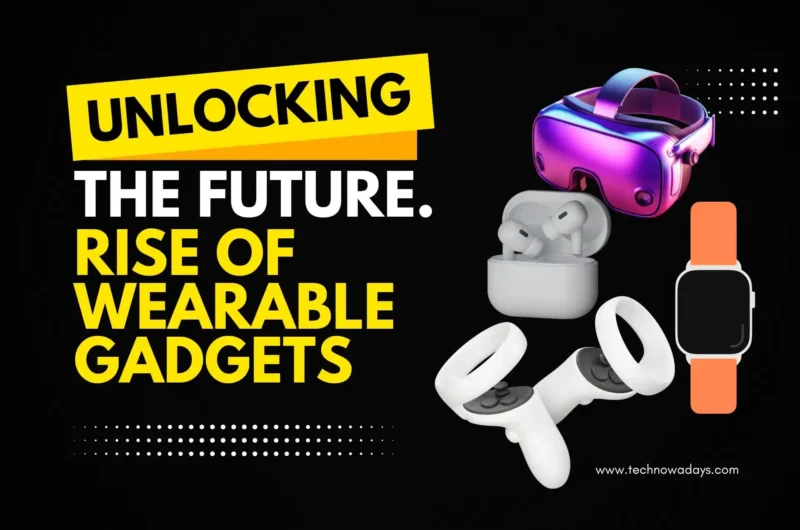Computers have moved from desktop tables to pockets and are now on your wrist or body. You can now make calls, check emails, check your health condition, post social media posts, or even play music without touching your smartphone.
These wearable devices have become a part of daily life. Let’s see how these gadgets are changing our way of life and what possible advantages and challenges they bring to our society.
What is Wearable Technology?
Wearable technology, a marvel of modern innovation, is a type of electronic device and equipment that can be worn on your body. These gadgets, from wrist watches and belts to jackets and glasses, are designed with the no-hand-needed concept in mind.
They can even be implantable, such as a heart monitor or birth chip, in the human body. And let’s not forget the whimsical side of wearables-tattoos that light up or change colors, and they too are a type of wearable gadget.
The very first wearable device was a wristwatch with four buttons, a simple yet groundbreaking innovation. However, modern wearable gadgets have evolved into sophisticated devices, equipped with different technical features.
They can send and receive messages using the Internet, a testament to the rapid progress of technology.
The most common example of wearable gadgets is smart watches, as you must have seen the rise of Apple smartwatches used by different people around you.
Some common examples of wearable technology are given below:
Smart Jewelry
Smart jewellery means wearable rings, necklaces, earrings, or any other piece of jewellery that is attached to smart technology and sensors. It allows you to communicate with your smartphone app using those sensors.
These sensors can tell you about your blood pressure, steps taken today, and other health information.
Smart Clothing
It results from the innovative and collaborative efforts of the fashion industry, tech engineers, and computer experts. Clothes can provide deeper insights into your body because their fabric can track details such as blood flow, heartbeat, temperature, or sugar level.
The technology can also track and communicate with your biometric data.
VR Headsets
VR headsets are relatively new technology that is developed to bring the virtual world to life. The user wears these headsets and steps into the world of virtual reality. Technology is famous for its use in education, health, and manufacturing.
Mainly you can see them in the gaming industry, such as Oculus Rift, PlayStation VR headsets, and HTC Vive. They have taken the gaming experience to the next level. These glasses will transport the user to the gaming world, where everything will feel real to you.
The Concept Behind Wearable Technology
To understand the reason behind the rapid rise in the use of wearable technologies, you should know the concept and deeper reality of these gadgets. What does a smartwatch do for someone other than telling time or allowing him to communicate with different smartphone apps? Well, it speaks about the physical condition of the person.
It enables the person to analyze his health conditions using real-time data. This psychology increases the user’s interest in these gadgets. For example, a person can’t count how many steps he has taken in a day.
However, it is not difficult for a smartwatch to provide the number of steps taken. This real-time data also encourages you to keep going with your fitness track and keeps you aware of how much you burn today.
Similarly, other gadgets, such as VR glasses, allow engineers and manufacturers to see a real-time representation of their product or plan. For example, after designing a 2D prototype, you can create a 3D plan or design to see how your product will look after manufacturing.
Applications of Wearable Technology in Our Daily Life
These hand-free devices have vast applications in our daily lives. They are used in all industries, from health to manufacturing and gaming. Let’s discuss each application of wearable gadgets one by one.
Wearables for the Research and Development Industry
Wearable gadgets can store real-time user data, which can help formulate the right strategies for research and business.
For example, companies can track their customers’ interests, lifestyles, preferences, and needs and use this data to accumulate accurate designs for their products that will meet customer criteria.
Companies use this well-searched data to create user-friendly products and to beat the market competition.
Wearables in the Healthcare Industry
The health industry is one of the most influenced sectors by wearable gadgets. These gadgets can help users stay fit and healthy by regularly informing them about the details of their physical condition.
For example, these wearable devices can help you find out your blood pressure, heartbeat, and other details. These smart devices will prevent you from forgetting about your medical conditions while working on daily tasks. Similarly, these gadgets are also quite helpful for tracking your exercise routine, jogging, and number of steps.
Wearables for Security
You must have seen those mini glasses equipped with a computer and camera to capture the surrounding area, trackers, and other mini devices used in spy movies to track the activities of any person.
These devices are now available worldwide, as facial recognition technology has made it possible to detect a person’s face in real time and search for their details using online databases. This technology is quite helpful for criminal tracking and security purposes.
Wearables in Gaming
Are you ready to walk on the land of Narnia or want to visit the Lord of the Ring’s Middle Land? You can indeed get a real-time feel with the gaming world. These wearable headsets can change the world around you and enhance your experience with the gaming world.
You can feel like you are walking among the characters and can enjoy real-time fights with your friends.
Future of This Cutting Edge Technology
Wearable gadgets are becoming popular due to their wide applications. These gadgets are equipped with all types of modern technology, including microprocessors, AI-powered features, VR technology, augmented reality features, and advanced sensors, which makes them highly competitive devices in the market.
Similarly, the world is also interested in integrating 3D devices in several industries, including health, engineering and manufacturing, automation, and education, where these devices will become the centre of attention.
Possible Risks and Challenges of Wearable Gadgets
Wearable technology is still new in the world, and introducing it on a mass level requires countering several challenges. Let’s discuss the possible challenges and disadvantages of wearable glasses.
- First, these items are quite expensive, and not everyone can purchase them. Apart from being out of common reach, this can further highlight the pre-existing class differences in society.
- Second, wearable devices require multiple devices, software, apps, and other attachable equipment to fully function, which can be problematic for any company or individual.
- These devices track and save your personal data in cloud storage, which can put your business details, confidential information, and personal data in danger due to any cyber attack.
- Moreover, it can cause people to lose touch with the real world or with their loved ones and society, which is already a problem due to the excessive use of mobile phones. Therefore, there must be training or counselling on the use of these gadgets to create a balanced and smart society.
Final Thoughts
Like any other technology in the world, wearable gadgets have both advantages and risks for society. Most people share the fear of the use of technical devices by putting them close to their body or by experiencing virtual reality; they will lose touch with reality, or it will damage their mental health.
However, we cannot stop the rise of these wearable gadgets, as they have unprecedented advantages for our society. But we can control how people use these gadgets and how these companies use our personal data to make our lives easier.
Technology can ultimately improve society if used responsibly.



